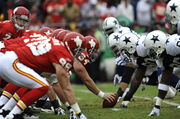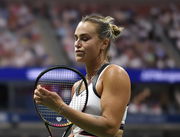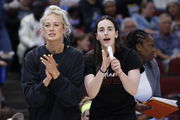
Reuters
Paris 2024 Olympics – Athletics – Women’s 100m Semi-Final – Stade de France, Saint-Denis, France – August 03, 2024. Sha’Carri Richardson of United States reacts after semi final. REUTERS/Sarah Meyssonnier

Reuters
Paris 2024 Olympics – Athletics – Women’s 100m Semi-Final – Stade de France, Saint-Denis, France – August 03, 2024. Sha’Carri Richardson of United States reacts after semi final. REUTERS/Sarah Meyssonnier
College athletes having control of their Name, Image, and Likeness was expected to revolutionize college sports in the United States. And it did. But not for everyone. In fact, it worked for a few athletes in a few sports. For instance, according to a report by ‘businesscollegeofsports.com’, the average value of all NIL deals was around a mere $1,800 in the first year.
Watch What’s Trending Now!
While there were some significantly higher deals, even a fair few seven-figure ones, those are mostly limited to football players. For most other sports, the tap is dry. This is especially the case for college track and field athletes. The sport is not a moneymaker anyway, with most track teams barely even breaking even.
Most college track and field athletes’ experience with NIL is encapsulated in the struggles of LSU Alia Armstrong, who trained under Sha’carri Richardson‘s LSU coach, Dennis Shaver. Her struggle was captured perfectly in the new Amazon Prime documentary, ‘The Money Game’, where she spoke about how she felt ‘underlooked’ by brands and struggled to understand why this was the case.
ADVERTISEMENT
New: #LSU hosts its exclusive premiere of “The Money Game,” and athletes like Livvy Dunne, Flau’jae Johnson and Alia Armstrong made an appearance on the purple and gold carpet. pic.twitter.com/B8dp0T91A1
— Jason Willis (@JasonWillis4) September 5, 2024
“When NIL first came about, I had no idea of what to do. I just think I was just kind of underlooked. And so I just really wanted to understand why I wasn’t getting these big-name brands, and I was struggling at the time. I reached out to [NIL executives] Taylor and Marie-Claire, and I said, ‘I’m too big of an athlete and too big of a name at LSU to not be making money’. And once they understood my financial circumstances, they wanted to help a lot,” she said.
The difficulties Armstrong faced were borne out by the numbers. ‘Sportsbusinessjournal.com,’ for example, estimated only 17% of NCAA athletes (Division 1) were able to participate in NIL activities in 2022. The LSU tracks and field star was among the 63% who found themselves out in the cold and unable to get any NIL deals. But things are improving, and as the NIL system, which is still pretty new, gets entrenched and an ecosystem is built around it, most are hoping things will improve. However, track and field is in an especially bad position since it is towards the bottom of the popularity list of all the NCAA sports.
ADVERTISEMENT
Sha’carri Richardson can serve as an example to college track and field stars
While it was hoped that the NIL system would take pressure off of college athletes to go pro, this hasn’t been the case for most college track and field athletes. Richardson, for example, went pro and left the LSU after only one year at the LSU. And she had very good reasons to do so. After all, she would have left life-changing amounts of money she would leave on the table if she didn’t.
ADVERTISEMENT
How much money exactly? Sha’Carri Richardson’s $20 million Nike deal is just one of the deals with a major brand that illustrates this point. However, with track and field athletes managing to get less than $2000 in NIL deals, on average, it seems the system isn’t working for them.
But it is unclear that even going pro would be much of a financial benefit for the vast majority of college track and field athletes. After all, the same problem of a handful of them being big enough names and brands in themselves to get the big bucks would persist even if they went pro. The solution, it seems, is the simplest one—make track and field more popular, much more popular than it is today.
Top Stories
NFL Makes Punishment Decision on Josh Allen Incident

Tiger Woods Gives Fan 1-Word Reply About PGA Tour Comeback Amid Leaked Schedule

NFL Makes Punishment Decision Against Cowboys on Chiefs’ Incident in Thanksgiving Game

Aryna Sabalenka Caught off Guard As Ball Kid Delivers Stunning Feat at Match-Point

Paige Spiranac Rubs Salt in Colt Knost’s Wounds With Latest Comments on His Amateur Golf Dreams

Sophie Cunningham’s Sharp Response Divides WNBA Fans Amid Caitlin Clark’s Project B Decision

But then again, this hardly needs to be said, as it is the most obvious and self-evident statement. And in an individual sport like track and field, most of the onus is on individual athletes. One solution can be to make the athletes aware that they are a business and they can be given at least crash courses on how to become a brand and market themselves, something Sha’carri Richardson did very successfully, in order to maximize their NIL earning potential. And for that, the colleges will have to play a more active role in educating these young athletes who are just out of high school. What are your thoughts on how athletes could make more money with their NILs?
ADVERTISEMENT
ADVERTISEMENT
ADVERTISEMENT
ADVERTISEMENT

